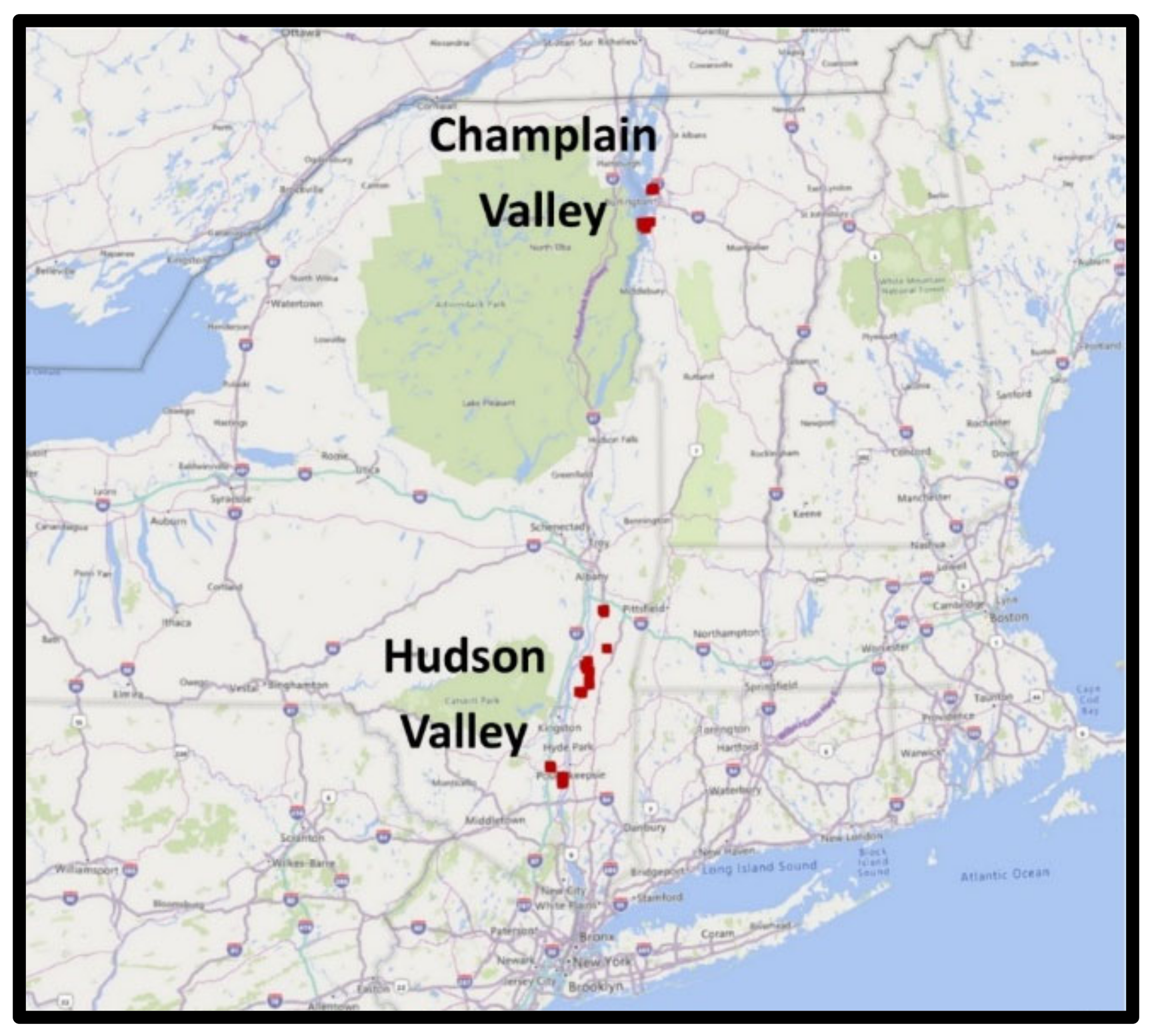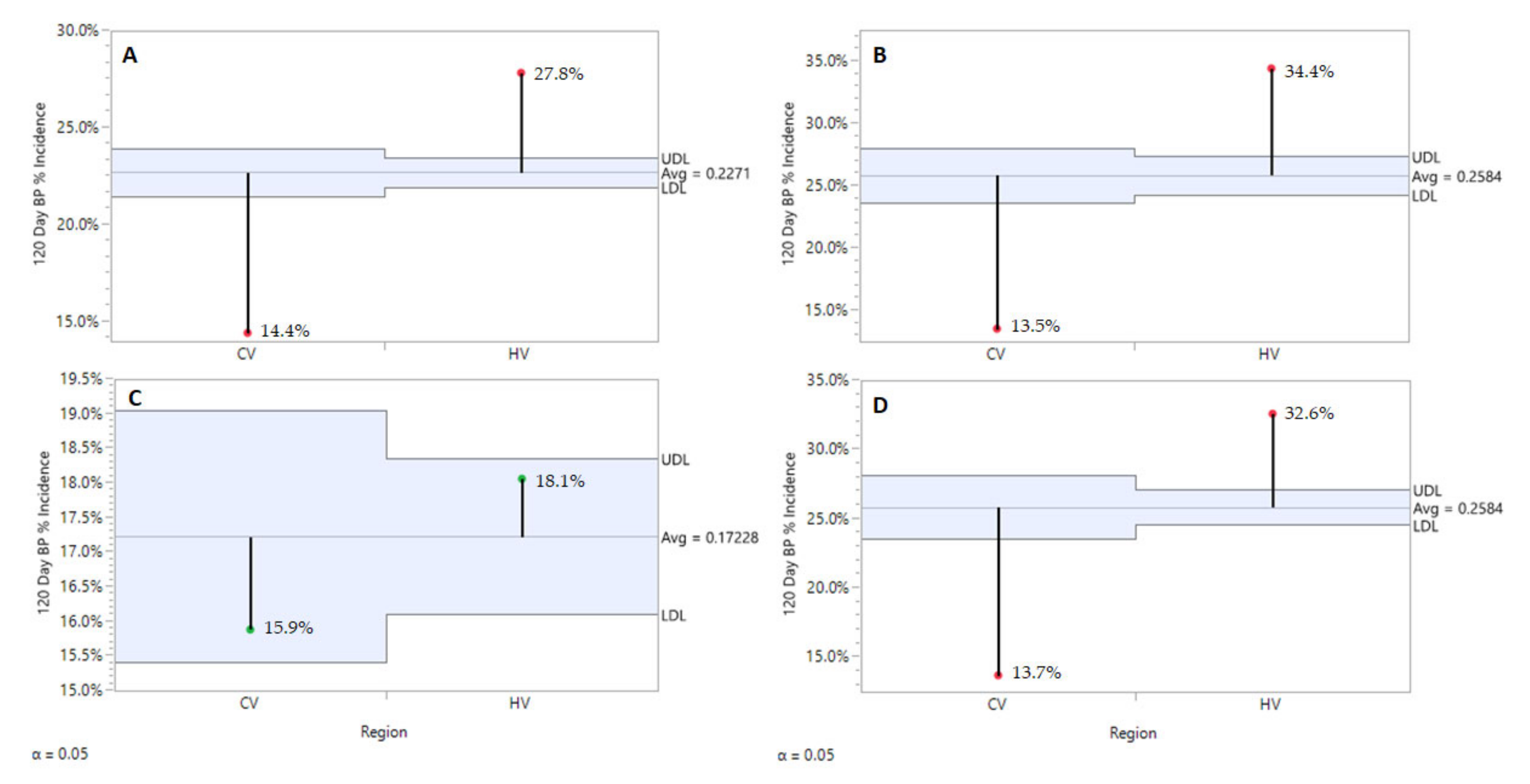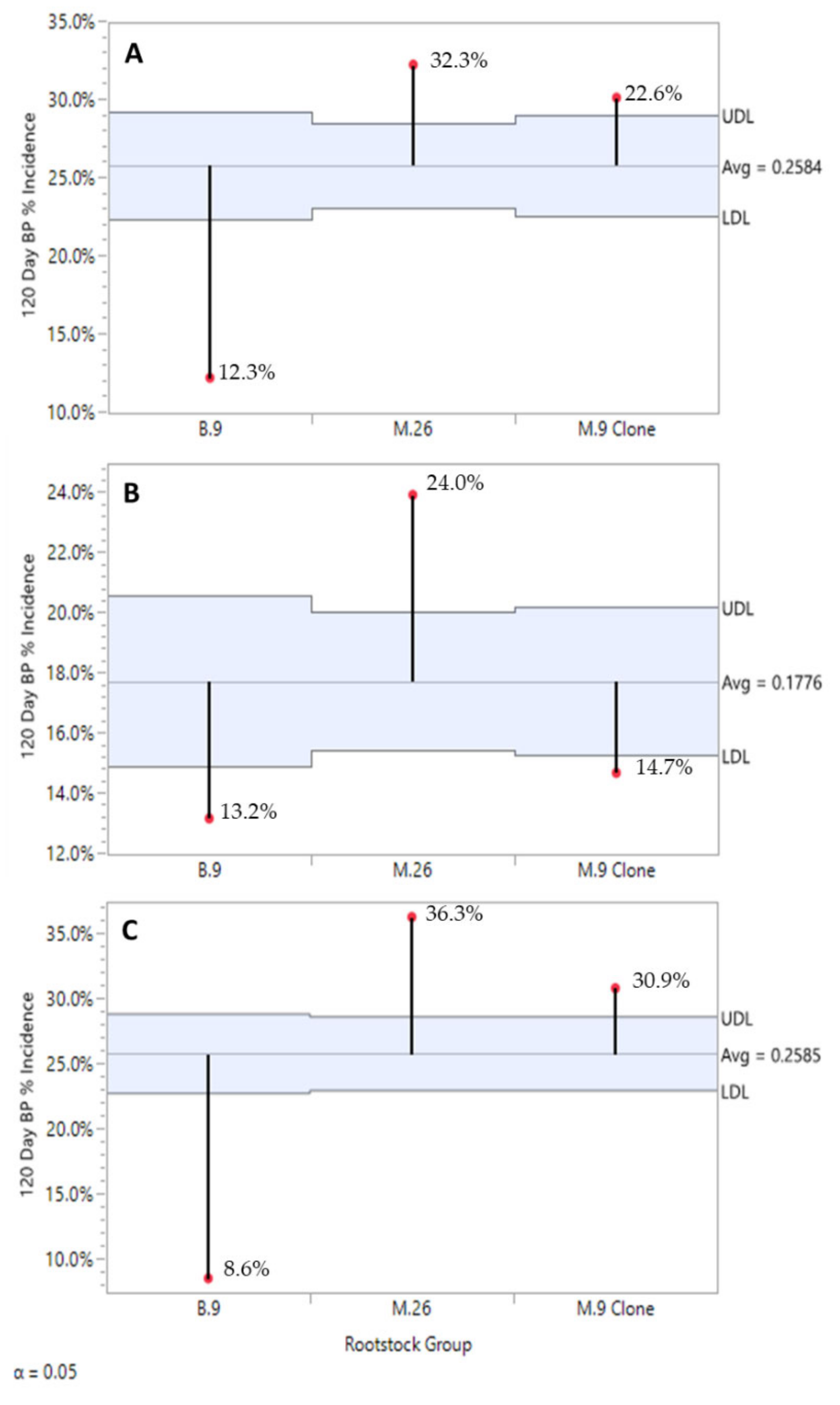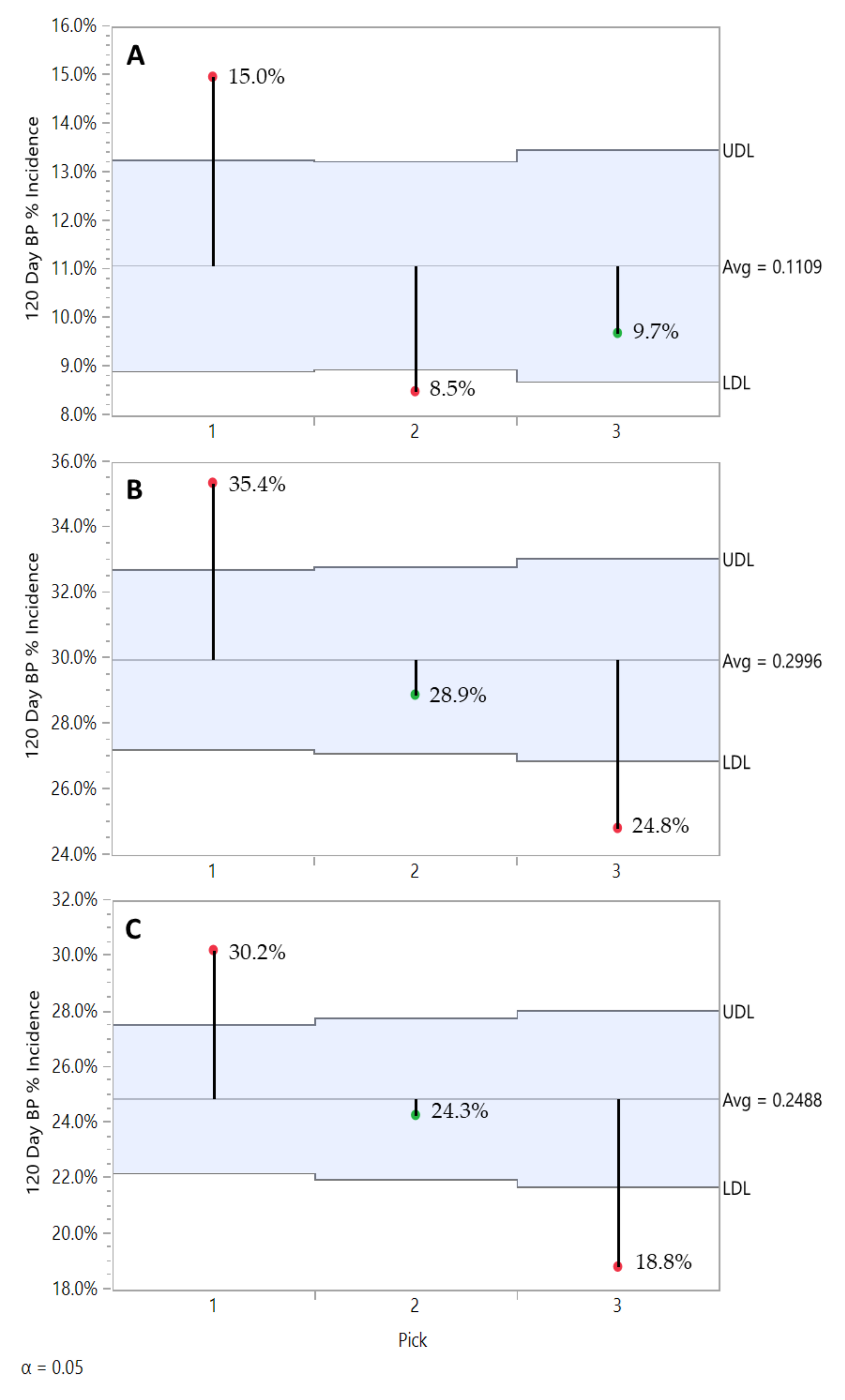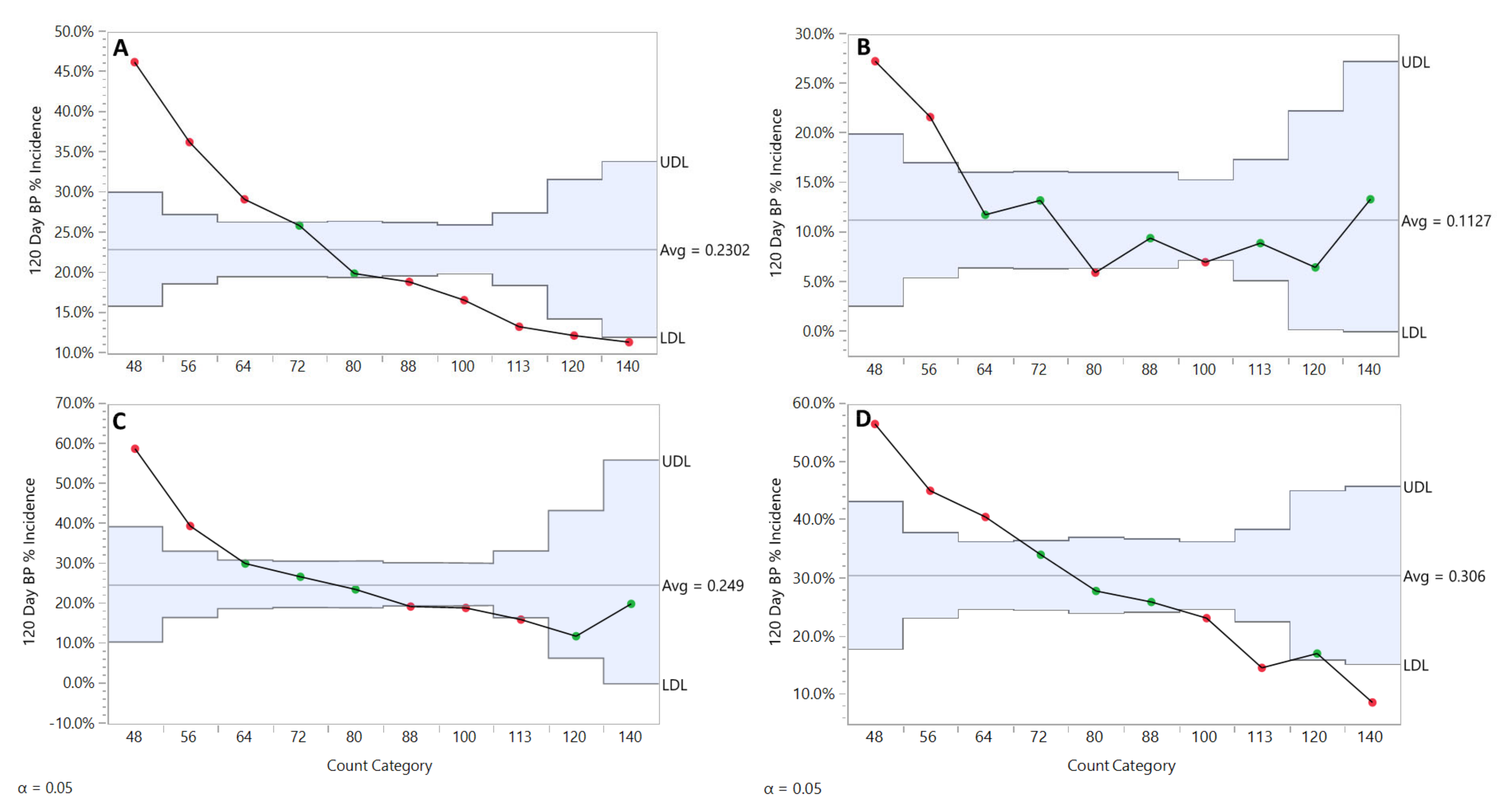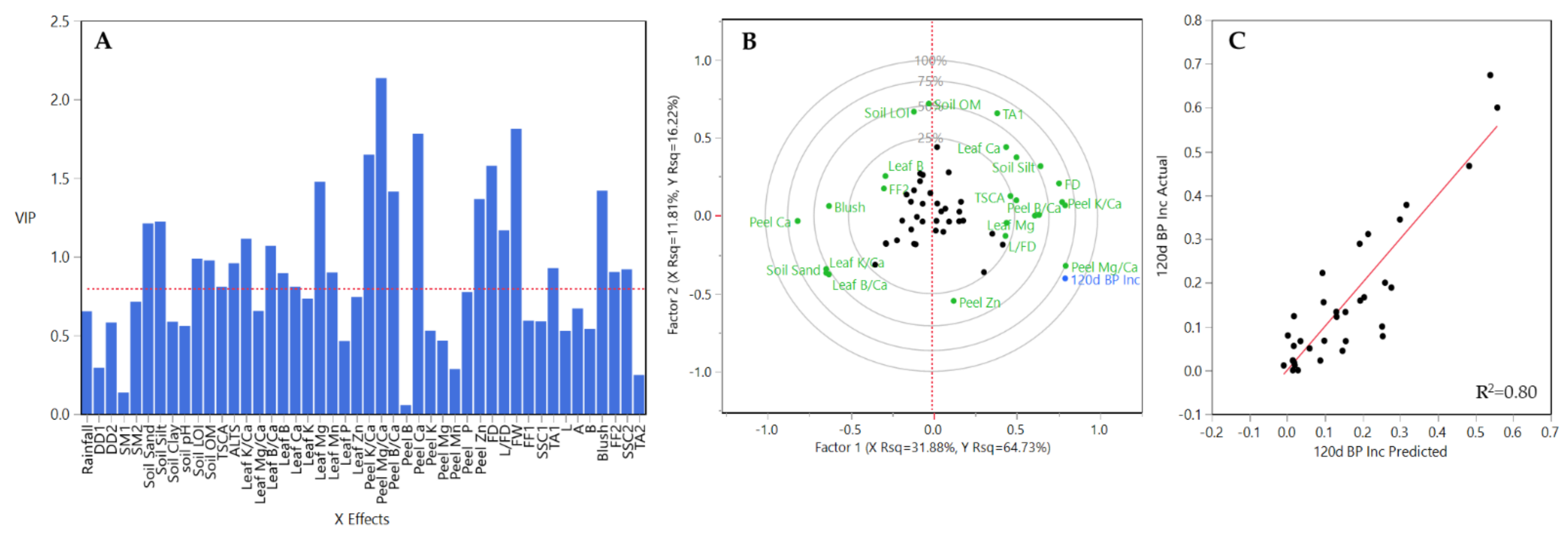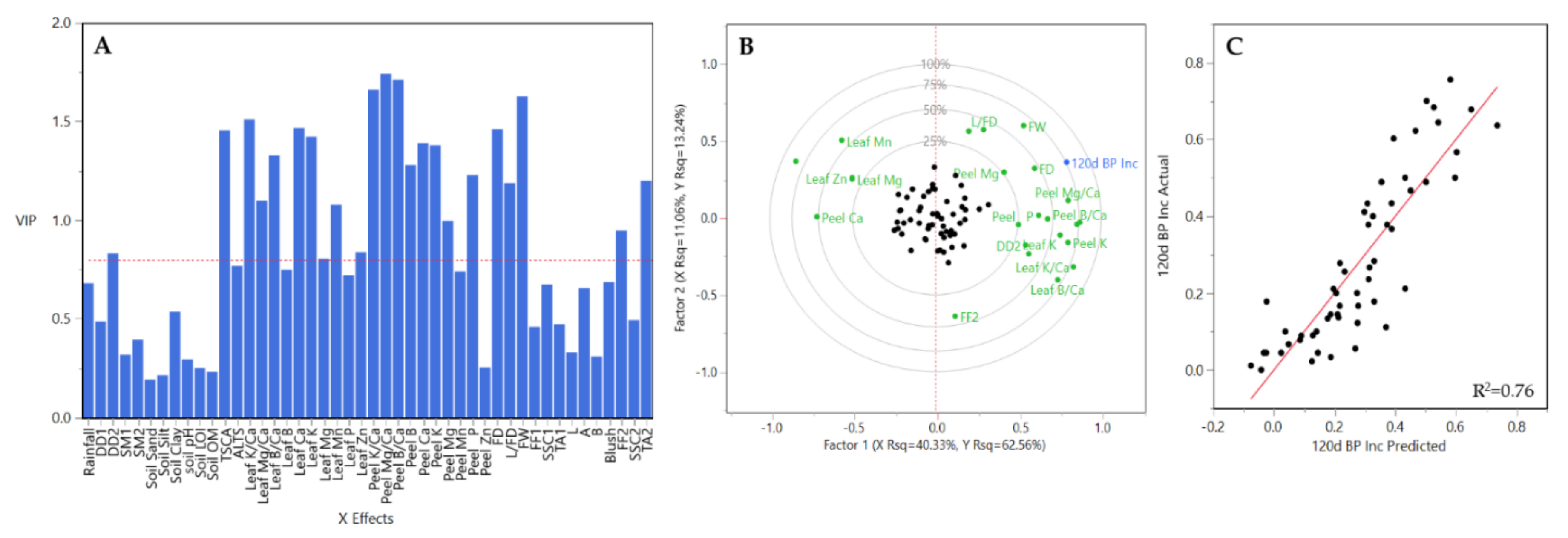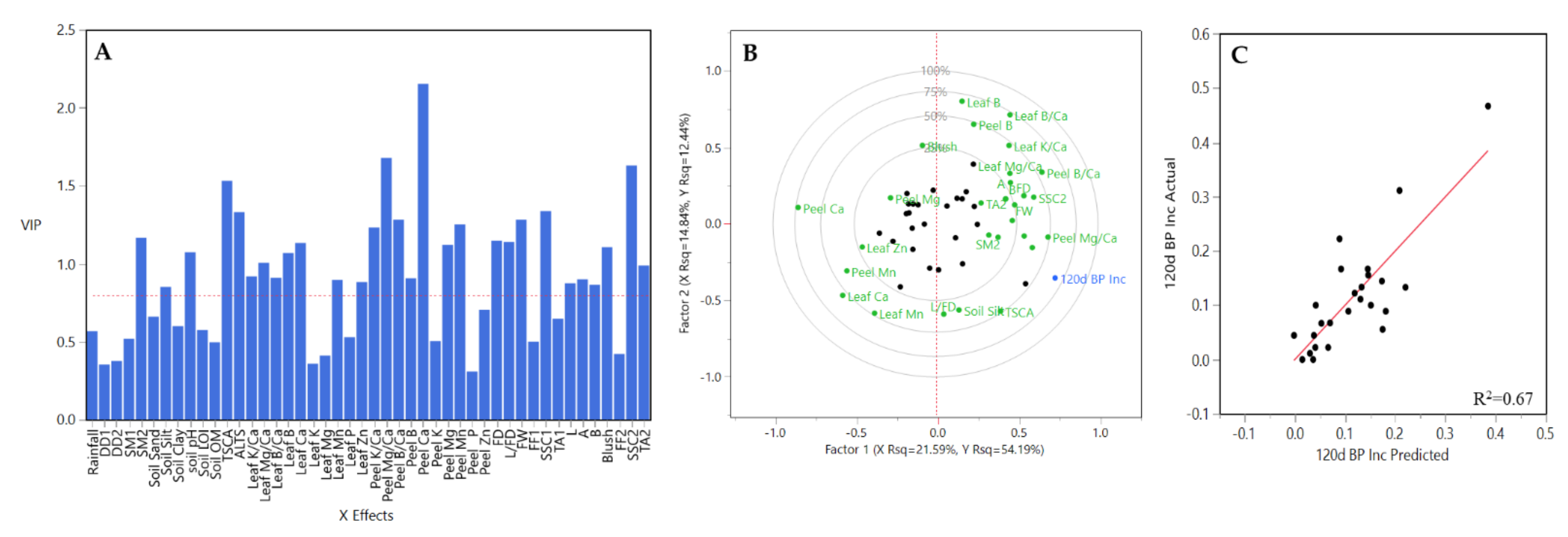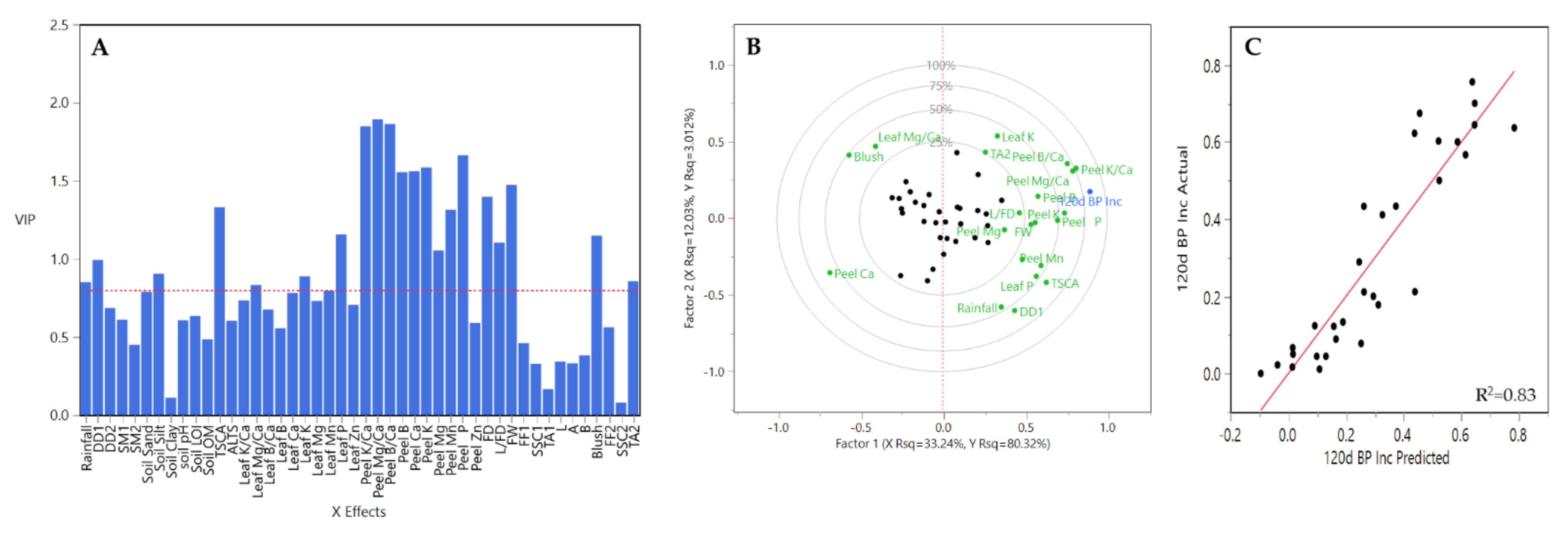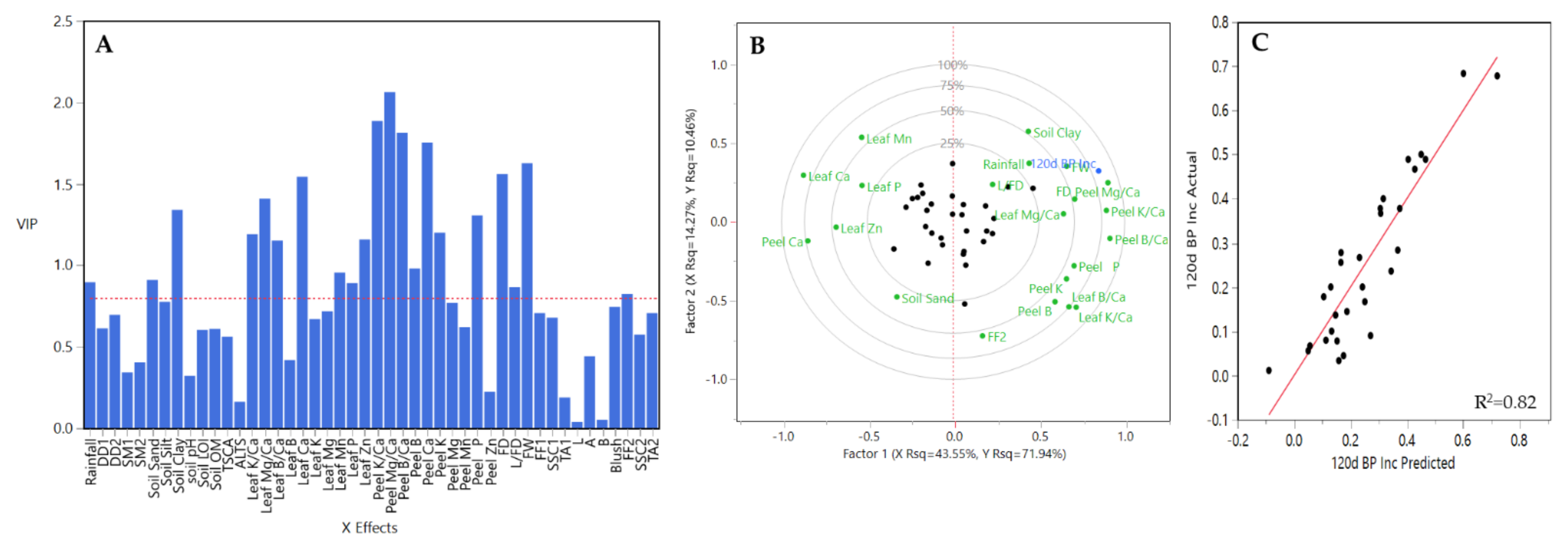1. Introduction
Malus ×
pumila Borkh ‘Honeycrisp’ is a variety of major economic significance and has achieved widespread commercial success in North America and Europe since its introduction by the University of Minnesota apple breeding program in 1991 [
1]. Currently, ‘Honeycrisp’ is the third most produced apple variety in the USA, after ‘Gala’ and ‘Red Delicious’. All three varieties comprise 48% of all apple production in 2020 [
2]. ‘Honeycrisp’ is a high-value bi-color apple that became popular for its unique fruit quality characteristics and palatability at harvest (juicy, crispy, and strong flavored) that are maintained during storage [
3]. However, it has developed a reputation for being a challenging apple to grow. In fact, it presents growers and marketers with several production and storage difficulties, such as alternate bearing, sunburn, bitter pit disorder (BP), soft scald, soggy breakdown, leather blotch and wrinkly skin [
3,
4,
5,
6,
7]. The correct pedigree of ‘Honeycrisp’, ‘Keepsake’ × MN1627 (‘Duchess of Oldenburg’ × ‘Golden Delicious’) [
8] may help to explain its susceptibility to bitter pit. ‘Golden Delicious’ is a bitter pit-susceptible apple, as reported in previous studies [
9,
10].
Bitter pit (BP) is a calcium-related physiological disorder that expresses as dark sunken necrotic lesions in the first few millimeters of the skin and flesh, typically near the calyx end of the fruit, and is the result of a complex interaction between fruit physiological factors, as well as certain environmental and horticultural conditions. Historically, more than 50% of fruit from young ‘Honeycrisp’ plantings is unmarketable due to bitter pit [
5,
11] and pack-out percentages can be even less after long-term storage. The commercial conditioning treatment of 7 days at 10 °C used to reduce risk of soft scald and soggy breakdown development, as well as recommended storage temperature of 3 °C exacerbate losses due to bitter pit [
12]. Despite this, an increasing number of hectares continue to be planted each year, and many blocks have yet to reach full bearing, increasing market supply. Therefore, as ‘Honeycrisp’ production continues to expand, particularly in North America, knowing as many variables as possible related to bitter pit will be necessary for the economic sustainability of this variety.
Producers have traditionally attempted to mitigate the expression of BP symptoms through the foliar application of calcium, with variable success. Many studies carried out in ‘Honeycrisp’ and other apple varieties such as ‘Golden Delicious’, ‘Fuji’ and ‘Braeburn’ contributed to the development of strategies to reduce bitter pit incidence [
10,
13] and models or methods to predict bitter pit before harvest [
12,
14,
15,
16]. Most are related to the mineral nutrition and bitter pit incidence relationship. Two studies reported a clear, positive relationship between potassium-to-calcium ratio and bitter pit incidence [
17,
18] (Valverdi et al., 2021; Fazio et al., 2020). However, mineral content is not the only criterion for the occurrence of bitter pit and does not always explain the presence or absence of symptoms in a particular orchard [
13]. Other factors such as early harvest, poorly drained fine-textured soils, light cropping, excessive tree vigor, excessive nitrogen nutrition, moisture stress, low boron, vigorous shoot growth, weather and soil conditions (hot and drying conditions, low soil pH), year, local environment, hormones, rootstock selection, foliar calcium programs and tree age can contribute to increase bitter pit risk [
14,
19,
20] and to explain the enormous variation in bitter pit incidence observed among commercial plantings. A study that compared B.9, M.9, G.41, and G.890 rootstocks reported a strong effect of rootstock on nutrient composition and partitioning as well as overall fruit quality and disorder incidence in ‘Honeycrisp’ apple [
18].
The aim of this study was to broadly examine potential contributors to the large variation observed in the rate of bitter pit incidence on ‘Honeycrisp’ in the New York State climatic environment. We focused on rootstock and region, analyzing weather, soil, horticultural and fruit quality variables, using multivariate and binomial distribution analysis techniques.
2. Materials and Methods
2.1. Plant Material and Site Description
From two distinct apple production regions within Eastern New York (Hudson Valley (HV), and the Champlain Valley (CV), thirty-four commercial ‘Honeycrisp’ orchards in Eastern New York State (NYS), USA, were initially selected randomly in the spring of 2016 on the basis of having recognized commercial success, a modern vertical axis or tall spindle planting system, and a modest tree size that would facilitate data collection. Larger tree forms such as semi-dwarf central leader on wider spacings were excluded on the basis of declining commercial viability (
Table 1,
Figure 1). Twenty orchards were located within the Hudson Valley (HV) in the southeast and fourteen were located within the Champlain Valley (CV), approximately 300 km to the north. Orchard age ranged from 4th leaf to 25th leaf, tree training was uniformly central leader, but planting system design included a variety of planting densities from tall spindle at 1 m × 3.6 m to vertical axis at 2.4 m × 4.9 m. The pest management program for each orchard was managed by the local grower according to accepted commercial practices with the exclusion of foliar calcium and Prohexadione calcium sprays. Pruning practices and crop load management were managed by the grower according to commercial standards. The experimental unit within each orchard was defined as six contiguous trees of uniform presentation deemed to be representative of the orchard as a whole. Beyond this initial selection, data collection from the experimental unit was restricted to the trees within the unit and not considered to be representative of the orchard as a whole. Approximately half of the selected orchards were irrigated by trickle systems from local ponds and wells. The remaining half had access to solid-set overhead irrigations systems grower, deployed on an as-needed basis during extended periods of dry weather. The irrigation strategies present in this survey study are representative of commercial grower practices in both growing regions.
2.2. Weather Conditions
For the years 2016–2018, meteorological data (degree days and rainfall) was downloaded from the nearest meteorological station for each orchard, often on-farm in close proximity. Degree day (DD) was calculated as the difference between the daily mean temperature and a base temperature of 3.9 °C. Then, annual rainfall (mm) and annual DD accumulation (from 1 January to 30 June and from 1 May to 30 June) were calculated (
Table 2). The two regions of this study are separated by approximately 320 km and have different climates. For the Hudson Valley, the average winter temperature is −2.1 °C and average summer temperature is 19.3 °C. Average annual precipitation is 73.1 cm. For the Champlain Valley, the average winter temperature is −5.6 °C and average summer temperature is 17.9 °C. Average annual precipitation is 82.4 cm.
2.3. Soil Conditions
A Watermark SS200 solid-state electronic soil water tension measurement sensor (Irrometer Company, Riverside, CA, USA) with a measurement range of 0–200 kilopascals was installed per manufacturer recommendations at a soil depth of 20 cm in the center of each 6-tree experimental unit. Measurement data was taken weekly for the period full bloom to harvest using a hand-held Watermark meter. A soil sample of 12 cores (both sides of each tree) from the depth range of 2.5–20 cm was taken in each experimental unit in 2016 and 2017. In 2018, a single sample of 20 cm × 20 cm × 20 cm was taken from a single site within each experimental unit as specified by the Cornell Soil Health Testing protocol.
Rapid Soil Texture: The non-organic, solid material in soils is composed of a mixture of mineral particle sizes, the relative amounts of which determine the soil texture. Textural class affects many of the important physical, biological, and chemical processes in the soil, but is not easily altered by management practices because it changes little over time. Although soil texture itself is not a soil health indicator per se, knowledge of the textural class informs the interpretation of soil health indicators. This Rapid Texture procedure involves dispersion of soil particles using sodium hexametaphosphate followed by the (1) isolation of the sand fraction using a 0.053 mm sieve, and (2) separation of the silt and clay fractions by settling.
Available Water Capacity: Available water capacity is the amount of plant-available water the soil can store. In the field, a soil is at the upper end of soil water storage when water that it cannot hold against the force of gravity has—this is called ‘field capacity.’ The lower end of the range is referred to as the ‘permanent wilting point,’ which occurs when only hygroscopic water remains (i.e., water tightly held so tightly onto soil particle surfaces that it is inaccessible by plant roots). Available water capacity is determined from measuring the soil’s water content at both field capacity and permanent wilting point in the lab and calculating the difference.
Wet Aggregate Stability: Wet aggregate stability is a measure of the extent to which soil aggregates resist falling apart (i.e., slaking) when wetted and exposed to the force of rain drops. This physical soil property is measured using the Cornell Sprinkle Infiltrometer, which rains for 5 min (delivering 1.25 cm of water) on a sieve containing a known weight of soil aggregates between 0.25 mm and 2.0 mm. Unstable aggregates slake and pass through the sieve, while the fraction of soil remaining on the sieve is used to calculate the percent wet aggregate stability. Soils with high wet aggregate stability are more resistant to water and wind erosion and show better overall soil health (e.g., infiltration, root growth, biological activity).
2.4. Horticultural Assessments
Within each experimental unit and for each year the following horticultural measurements were recorded, and samples taken: trunk diameters were measured at a point 30 cm from the ground and used to calculate trunk cross-sectional area (TCSA) in cm2 in the spring. Ten random terminal shoots were selected per tree, five per side, following terminal bud set in the late summer, and measured for length (mm). A minimum of 20 terminal shoot leaves of moderate age were sampled from trees in each experiment unit for nutrient analysis at approximately 80 days post-full bloom. Apples were sampled for peel mineral analysis at approximately five weeks before first harvest. A spiral peeler (Apple Mate 861, Norpro, Moodus, CT, USA)) was used to produce peel of 0.8 mm thickness with the calyx half separated from the stem half. Two fruits per tree were sampled from each experimental unit for a total of twelve. Peels from each experimental unit were pooled with calyx and stem-end tissue analyzed separately for mineral content. Results presented are from the calyx-end samples.
2.5. Plant Tissue and Soil Mineral Analysis
Peel and leaf tissue mineral analysis: Samples were digested with nitric and perchloric acids using the Vulcan 84 automated digestion system (Questron Technologies Cor. Mississauga, ON, Canada). Approximately 0.3 to 1.0 grams of sample were weighed into 50 mL Teflon containers plus 0.25 mL of 80 µg per mL of yttrium. This was used as an internal standard. The digestion system automatically added (using syringe pumps) 5.0 mL of 67–70% nitric acid (OmniTrace, Delray Beach, FL, USA) plus 3.0 mL of environmental grade 70% perchloric acid (GFS chemicals, Columbus, OH, USA). In this system, the samples were heated to 110 °C over 40 min and held for 60 min. The temperature increased to 160 °C over 20 min and was held for 15 min. An additional 1.0 mL of nitric acid was added and the samples were heated an additional 20 min at 160 °C. After cooling, 20.0 mL of 18 mg water was added. The solutions were then analyzed using an axial viewed ICP-OES. (Spectro Arcos FHE12, Kleve, Germany). Results are not corrected for moisture content.
Organic matter content: The pool of organic matter (OM) in soil includes the carbon-containing solid materials which are, or are derived from, living organisms including plants and soil microorganisms. Soils with high OM content tend to require lower inputs of nutrients and are more resilient to drought and extreme rainfall. The percent OM was determined by measuring the mass loss on ignition (LOI) at 500 °C in a furnace. At these extreme temperatures, carbonaceous materials are burned off (i.e., oxidized to carbon dioxide (CO2)), while non-organic mineral materials remain.
pH and soil mineral testing: A traditional soil fertility test analysis designed for application in the Northeastern USA was used to determine soil pH and estimate plant nutrient availability. Nutrient analysis was performed using a Modified Morgan (MM) extraction and reported in available nutrients. Samples were sieved past 2 mm and placed in labeled paper cups, dried at 50 °C before extraction. For the MM extraction, soil was extracted at a 1:4 soil/solution ratio with Modified Morgan solution [0.62 N NH4OH + 1.25 N CH3COOH] buffered at pH 4.80 with the filtrate subsequently analyzed by ICP for Ca, Mg K, Fe Al, Mn, and Zn. Soil pH is a measure of hydronium ion (H3O+, or more commonly the H+) activity in the soil solution. Soil pH influences many facets of crop production and soil chemistry, including availabilities of nutrients and toxic substances, activities and nature of microbial populations, and activities of certain pesticides. A suspension of two parts water to one part soil (2:1 ratio) was prepared and allowed to stand at room temperature for one (1) hour. The pH was then be determined using a manual pH meter or robotic system. Soil pH was measured in water, macro- and micro-nutrients were determined using modified Morgan extractant.
2.6. Fruit Quality and Bitter Pit Evaluation
Over three years (2016–2018) and each orchard, three weekly picks of commercial-grade fruit were made at harvest with the initial pick commencing at the time of the conventional commercial first harvest for each region. Forty-five apples were harvested at each pick. Fruit selection criteria for each pick mirrored the common commercial practice of spot-picking based on the visual intensity of the red blush. A 15-apple subsample was randomly selected and evaluated for external and internal fruit quality and maturity (FQM) parameters. Apple dimensions such as diameter (FD) and length (L) were measured using a digital caliper. Fruit shape or sphericity was then calculated as FD/L ratio. Fruit weight (FW) was determined by a digital scale. Red color coverage (% blush) was visually scored as a percentage in 10% increments. External ground color from both cheeks (CIELAB coordinates L, a, b) was determined using a Minolta Chroma Meter CR-200 portable tristimulus colorimeter (Minolta Corp, Osaka, Japan) in 2016, and an Agrosta Texture Analyzer (ver. 2016, Serqueux, FRA) in 2017 and 2018 measuring RGB then converted via algorithm to CIELAB L, a, b coordinates. Flesh firmness (FF), expressed in Newtons, was determined with a firmness tester (EPT, Lake City Technical Products, USA in 2016 and an Agrosta Texture Analyzer (ver. 2016, Serqueux, FRA) in 2017 and 2018, using an 11 mm diameter tip. Two readings were taken from opposite peeled sides of each fruit. Soluble solids content (SSC) and titratable acidity (TA) were determined using juice extracted with an automatic juicer (Maverick). SSC was determined using a digital hand-held refractometer (Atago Pal-1, Tokyo, Japan), with the results presented as °Brix. TA was determined by titrating 5 mL of juice with 0.1 sodium hydroxide (NaOH) to an end point of pH 8.2, and the results were expressed as g malic acid 100 mL
−1 (Semi-Automatic Titrator HI94532U-O1, Hanna Instruments, Smithfield, RI, USA). The ripening index (RI) was determined as SSC/TA ratio. The starch pattern index (SPI) was determined for each fruit according to the Cornell 8-step scale published by Blanpied and Silsby [
21].
The remaining thirty apples were stored in regular atmosphere at 2.2 °C for 120 days (without conditioning at 10 °C). Each of the 30 apples were labelled with a unique number and data specific to that fruit was collected whenever practical with non-destructive measurements made as described for the 15 apple FQM subsamples. BP incidence and % surface area in 10% increments was rated at harvest and at 60 and 120 days post-harvest. At 60 days, individual apple data was collected on BP severity by counting lesions. In addition, at 120 DAH (days after harvest), color and FF were evaluated at the individual apple level, SSC and TA were evaluated at the group level.
2.7. Statistical Analysis
The combinations of year and region and year and rootstock were built to evaluate their effect on all traits studied in this study. The t-Student and HSD Tukey tests were used to compare means at the 5% confidence level. Pearson correlation coefficients were determined to study correlations among traits. Partial Least Square Regression models (PLSR) were run to correlate weather, soil, horticultural and fruit quality traits as X-variables, and bitter pit incidence after 120 days of storage as response variable (Y-variable), to find the variables that had most weight for discriminating among regions and rootstocks for ‘Honeycrisp’. The non-linear iterative partial least squares (NIPALS) algorithm was used. The Leave-One-Out validation was used to select the number of factors. The function yields two metrics: the variable importance in the projection (VIP) and the regression coefficient. The VIP indicates the weighted sum of squares of the PLS loadings and represents the relative importance of the given predictor (X-variable) in the PLS model. VIP values above a fixed threshold value of 0.8 are considered significant [
22]. The sign of the regression coefficient indicates the direction of the relationship between an X-variable and the Y-variable, while the magnitude of the regression coefficient reflects the VIP and is proportional to the contribution of all X-variables to bitter pit incidence at 120 days of storage. In addition, loadings were also calculated and plotted to give another way to view the relationships between the Xs the Ys and the PLSR factors. Whenever practical for data collected and recorded at the individual apple level, binomial bitter pit incidence data was analyzed directly for treatment differences using the Analysis of Means of Proportions (AMP) procedure. Continuous fruit weight and firmness data, when collected and recorded at the individual apple level, was analyzed directly for treatment differences using the Analysis of Means Methods (AMM) procedure. AMP and AMM results were presented in graphical form as well as in tables. All statistics analysis were performed using JMP software (Version 14, SAS Institute Inc., Cary, NC, USA). Bitter pit incidence data was arc-sin square root transformed and the non-normal distributions of average length terminal shoot and BP lesion density were rank transformed.
4. Discussion
In the course of this work, we evaluated a high number of parameters as possible indicators of BP incidence, including weather and soil traits, horticultural and fruit quality characteristics, through the perspective of region and rootstock choice, by conducting a detailed survey of 34 ‘Honeycrisp’ blocks distributed across two growing regions in Eastern NY, which at the end totaled 30 blocks. Our goal was to describe as much of the biological and abiotic world that our 6-tree experimental units were expected to thrive in while producing marketable fruit in commercial settings. The authors can say with confidence that the commercial producers who donated their orchards to this study were among the most skilled in New York State, with well-managed ‘Honeycrisp’ plantings.
Regional and local environmental and soil conditions must be taken in consideration when planting a new orchard and may be significant contributors to BP predisposition. To the best of our knowledge, this is the first study evaluating the region effect on the occurrence of BP. After three years and comparing the two regions, we found that, in general, ‘Honeycrisp’ orchards from the HV region presented high BP incidence. This region received more rain and experienced higher temperatures over the study period, which may explain partially the difference in BP.
In addition to region, rootstock choice is one of the most critical elements of any apple orchard to provide sufficient growth control, enhanced precocity, higher yield, improved adaptability to environmental conditions, and better fruit quality [
25]. In addition to effects on these traits, apple rootstocks have a diverse influence on the nutritional status of the tree canopy, are implicated in the physiology of BP and, therefore, can affect the occurrence of BP [
26,
27,
28], as it is demonstrated in our results. However, the BP response to tissue mineral status is variable depending on the rootstock and the region where it is planted. As a result, the occurrence of BP can be more or less intense or absent even as local tree tissue mineral measurements suggest otherwise.
We evaluated three of the most popular rootstocks used in high-density apple orchards in New York State: B.9, M.26 and M.9 clones [
25]. Among them, fruits from ‘Honeycrisp’ grafted on M.26 were slightly more susceptible to BP than those from M.9 clones and much more susceptible than B.9. In agreement with Lordan et al. [
28], B.9 rootstocks had a much lower incidence of BP compared to M.26 and M.9 clones, even in the very dry year of 2016. In general, B.9 BP incidence values did not differ significantly among years by region, even when both regions were evaluated together. Kim and Ko [
29] reported that BP is more intensive on moderate, vigorous rootstocks compared to less vigorous rootstocks, which is consistent with our results, as M.26 is the most vigorous rootstock in terms of TCSA evaluated in this study. Terminal shoot extension was a poor indicator of vigor and BP incidence as ALTS was very similar between the three rootstocks while BP differed significantly.
In terms of horticultural parameters, region and rootstock had a significant effect on some of these traits, results that were somewhat expected. Other authors have also reported that region and rootstock can affect similar horticultural traits under Hudson Valley and Champlain Valley climatic conditions for ‘Gala’, ‘Fuji’ and ‘Honeycrisp’ [
7,
25,
28]. In this study, the most vigorous rootstock, M.26, had higher leaf K/Ca, Mg/Ca and B/Ca ratios, leaf K, and peel B, but lower leaf Ca, Mn, and P values as compared to B.9 and M.9 clones.
Between regions, ‘Honeycrisp’ orchards, despite showing significant differences, some of these traits were not correlated to BP incidence after a period of refrigerated storage. ‘Honeycrisp’ fruits from CV orchards tended to have less BP incidence after storage (less than 10%) compared to those from HV. This lower BP value may explain the lower number of correlations with the horticultural traits, as well as the higher BP incidence values of M.26 orchards from HV could explain the higher number of significant correlations with horticultural traits compared to those from CV region.
This is the first study reporting rootstock effect on correlations between BP and horticultural traits. Little correlation was found between BP incidence after storage on ‘Honeycrisp’ fruits from B.9 in terms of horticultural traits, TCSA, peel Mg/Ca and peel Ca, whereas more significant correlations were found in fruit from the M.26 and M.9 clones, mainly the peel minerals. The lower BP incidence values from B.9 fruits could explain the lack of correlations compared to M.26 and M.9 clone rootstocks. These two rootstocks had some correlations in common, such as peel K/Ca, peel Mg/Ca, peel B/Ca, peel B, peel Ca, peel K and peel P, but M.9 clone rootstocks had higher values.
Recent studies have shown that BP, a Ca
2+-related deficiency disorder, is not necessarily related to low Ca
2+ concentration in fruit tissue in a “global” sense. In fact, chemical and X-ray analysis have shown that apple fruit tissue with visual Ca
2+ deficiency symptoms had higher Ca
2+ concentration than healthy fruit tissue [
30]. Most Ca
2+ in fruit tissue, between 60 and 75%, is bound to the cell wall. More Ca
2+ binding to the cell wall is consistent with the finding that BP-damaged tissues have more Ca
2+ than the surrounding healthy tissues [
31,
32]. In agreement with this statement and previous studies [
3,
33], we found a high and negative correlation between peel Ca
2+ concentration and BP incidence after storage for all three rootstock categories and two regions.
Fruit quality traits were also affected by region and rootstock, in agreement with previous rootstocks studies performed in ‘Gala’, ‘Fuji’, ‘Honeycrisp’ and ‘Red Delicious’ under Hudson Valley and Champlain Valley climatic conditions [
7,
25,
28,
34]. Both regions (CV and HV) had similar correlations between fruit dimensions and BP incidence after storage, despite showing significantly differences on these traits. However, blush only correlated with BP on those ‘Honeycrisp’ from CV. BP incidence after storage had few and inconsistent correlations with fruit dimensions and fruit quality traits when rootstocks were compared. ‘Honeycrisp’ fruits from M.26 rootstock, which had in general smaller FD because they were more elongated but similar FW to B.9 and M.9 clones, presented a moderate positive correlation with BP incidence after storage on these three parameters, and a medium negative correlation with blush. In contrast, B.9 did not present any correlation on the same traits, while M.9 clones did in FD and FW, perhaps this finding is associated with lower levels of BP and less variability in the B.9 orchards. A similar trend was observed regionally for B.9.
‘Honeycrisp’ fruits were harvested at optimum commercial harvest quality at each of the three weekly picking times. Minor fruit quality and maturity differences between picks at harvest were found but considered to be commercially acceptable for storage and marketing purposes. BP incidence at the time of harvest was relatively low and varied only slightly by pick with the pick 3 (last pick) apples expressing slightly more BP. It would be unlikely for a commercial producer to observe the slight uptick in BP in the field. In contrast, BP incidence after storage showed a significant decreasing trend in each of the later picks in the HV, while in the lower BP environment of the CV, picks 2 and 3 were found to be similar, and lower than pick 1.
‘Honeycrisp’ fruits picked earlier were firmer, smaller, with more red blush and presented higher BP in storage. Therefore, in agreement with Prange et al. [
35], BP is more severe in early-picked than in later-picked apples. However, there may be an optimum stage of fruit maturity (or harvest date) for ‘Honeycrisp’ when fruit are of sufficient size and color to meet market requirements while minimizing the risk of manifesting BP, especially if the fruit are >250 g in size. Our study did not attempt to specifically evaluate that possibility. We closely adhered to commonly accepted commercial quality standards. In any case there may not be much room available to adjust harvest dates and maintain a balance of quality factors acceptable to the marketplace.
Increasing fruit size has been associated with increased BP incidence [
36]. The relationship was further defined by Reid and Kalcsits [
37] in a water relations study where fruit size was categorized into four classes based on diameter, with BP incidence effectively doubling between the 80–90 mm and over 90 mm categories. Our study takes this approach a step further, with the use of ten commercial weight categories in the range of 48 count (largest) down to 140 count (smallest) based on common marketing practice. For all storage fruit in this study the frequency distribution of across the ten categories approximated the bell shape of a normal distribution with the top of the “bell” flattened (data not shown), with 92% of the fruit falling into count categories 56 to 113. For all three rootstocks, fruit in the categories 48 and 56 were the most susceptible to BP. While our categories were based on weight ranges, our fruit diameter data shows that 48 count apples averaged 94.1 mm and 56 count apples averaged 89.3 mm, both categories roughly equivalent to the largest size category described in the Reid and Kalcsits [
37] study which also experienced an elevated incidence of BP. The relationships start to change by rootstock as we move into the more commonly marketed size categories. Fruit produced on B.9 had a relatively neutral relationship of BP to size in the range from 64 to 140 as the BP incidence curve flattened and oscillated around a mean of 11.2% incidence. Fruit produced on M.9 demonstrated a decline in BP incidence with decreasing size, with incidence falling from 29.2% (64 count) to 13.3% (113 count). Fruit produced on M.26 demonstrated the most severe relationship falling from 40.6% to 14.6% over the same count size range. There are orchard management implications associated with these findings. As much as the industry recognizes that larger fruit have more bitter pit, as a practical matter the first priority of a properly managed crop load reduction program is to produce fruit in marketable sizes, and then facilitate adequate return bloom to avoid biennial bearing. Minimizing the production of 48 and 56 count apples will have a positive effect on orchard financial returns for all rootstocks represented in this study. Beyond that, a shift in frequency distribution to smaller fruit is not likely to help in a B.9 orchard and will only slightly reduce the average BP incidence in M.9 clone and M.26 orchards.
While BP incidence has been related to individual mineral element concentrations and ratios of mineral pairs in many apple studies, one should not underestimate the complex environment that the roots (soil type, soil pH, water availability, soil moisture, etc.), and the scion (rainfall, light intensity, crop load, heat unit accumulation) operate in, in conjunction with the final fruit traits influence by producer management practices during the course of the dormant and growing seasons. For this reason, we pooled together all the traits evaluated in this study, except for CL, which was not evaluated in 2018, to identify the PLS prediction model on BP for each region and each rootstock based on the NIPALS algorithm.
Based on the results, the PLS prediction model for each region (CV and HV) and each rootstock (B.9, M.26 and M.9 clone) showed a different threshold of variables correlated to BP, described above for each PLS prediction model. However, comparing all PLS analysis, only seven VIP variables were in common, peel K/Ca, peel Mg/Ca, and peel B/Ca ratios, peel Ca, FD, L/FD, and FW, showing the great variability found in this study. It is also interesting to point out that none of the environmental variables and soil variables evaluated in this study were VIP variables in common among rootstocks or between regions. The 34 orchards evaluated in this study over three years represent a wide range of these variables, therefore, these results could help to emphasize their influence on BP incidence when taking in consideration each rootstock and each region as a single unit to evaluate.
The results of this work have the potential for a dramatic impact on commercial management and mitigation of BP in ‘Honeycrisp’ production. In order to facilitate real-time management changes, producers and marketers need practical tools and proven horticultural practices that mitigate bitter pit incidence and reduce storage decision risk. Bitter pit prediction models are currently in various stages of development, validation, and commercial implementation [
12,
16,
38] with all three taking different approaches to meet the same goal of reliable pre-harvest prediction of ‘Honeycrisp’ fruit BP performance in storage. Recommended approaches should be on those that are simple to implement at a low cost to the producer. However, the large number of variables suggests that simple and commercially achievable models consisting of 1–3 variables will always be lacking in absolute accuracy. Fortunately for practical implementation within the apple industry, accuracy thresholds for commercial implementation are more tolerant of error than those considered acceptable in academic settings. The goal is to provide effective storage management guidance which ultimately protects the producer from making the unprofitable decision to store fruit from an orchard that turns out to suffer substantial losses to BP months later.
